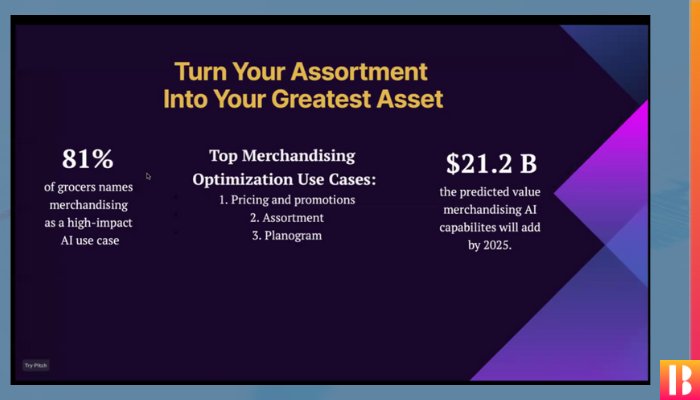AI for Grocery Retail Assortment
Artificial intelligence is an unavoidable topic. Everyone’s talking about ChatGPT and similar technologies… grocery retailers included. As retail businesses explore how to leverage AI, we suggest understanding the use cases, challenges, and benefits. Generative AI’s impact on productivity could add trillions of dollars in value to the global economy. McKinsey says that in retail and consumer packaged goods, the potential impact could be as significant as $500 billion – $660 billion a year.
How can AI help retailers improve business – especially in areas like pricing, space planning, and assortment? AI’s ability to analyze vast amounts of data and make intelligent decisions is helping innovative grocery retailers build consumer loyalty and enhance operations.
In June 2023, Grocery Doppio’s #AIinGrocery virtual event focused on the use cases of AI in grocery. Bungee Tech joined to talk about the role of AI in assortment. Click here if you’d like us to send you the slide deck from our presentation.
“Shoppers today are redefining value and finding it goes beyond just price to include quality, relevance, experience and convenience,” said Doug Baker, Vice President of Industry Relations at FMI.
Power & Potential
“Shoppers today are redefining value and finding it goes beyond just price to include quality, relevance, experience and convenience,” said Doug Baker, Vice President of Industry Relations at FMI.
During the #AIinGrocery event, Grocery Doppio dropped some interesting facts:
- 81% of grocers name merchandising as a high-impact AI use case
- Pricing & promotions, assortment, and planogram are the top merchandising optimization use cases
- Merchandising AI capabilities will add $21.2 billion in predicted value by 2025
There’s so much power and potential for AI’s uses…
Inventory Management
AI-powered inventory management systems leverage predictive analytics to optimize stock levels. By analyzing seasonal trends, customer demand patterns, and weather forecasts, AI can predict product demand. The benefit = stores maintain the right stock levels, reducing waste and improving efficiency.
Automated Checkout
AI-driven checkout systems will use computer vision, sensor fusion, and deep learning algorithms to automatically detect items in a customer’s cart and charge them accordingly. The benefit = no need for long lines, reducing waiting times and boosting convenience.
Enhanced Supply Chain
AI optimizes supply chain management by analyzing transportation routes, weather conditions, and inventory levels. This helps retailers streamline their logistics, minimize transportation costs, and ensure timely deliveries. An efficient supply chain benefits retailers and consumers.
Competitive Intelligence
AI enhances competitive intelligence processes. Competitive intelligence tools gather, match, and analyze data about a competitive environment and use it to improve performance. The best competitive intelligence providers use ML-driven approaches so retailers can outpace the competition.

Actionable Assortment Data
Historically, you’ve probably relied on POS and syndicated data for assortment optimization. The problem is – without a machine first approach – it’s tough to see the whole picture or quickly adapt to market changes.
Let’s talk about competitive intelligence as an assortment optimization tool or its assortment gap management capabilities… Your competitive intelligence program should help you…
- Determine the right prices for the right products.
- Find out which products are relevant to your customers in the categories you operate.
- Identify gaps – in flavor, product size, or location.
- Quantify potential revenue impact for new products.
Blending In Store & Digital Experiences
Assortment is a critical aspect for grocery retailers – it allows you to meet the needs of your most valued customers and gives you an opportunity to win shoppers from competitors. Grocers have to look at assortment information for brick-and-mortar stores and ecommerce sites because shoppers are choosing a hybrid approach to grocery buying. The line between in-store aisles and digital shelves is very blurry. 69% of all 2023 grocery sales are digitally influenced.
Omnichannel is table stakes – so every retailer needs to optimize assortment to meet online and in store shoppers. To achieve the best assortment across channels, you need in store and online data coverage for the full picture.
Omnichannel competitive data provides retailers with assortment, price, promotion, and availability data. With these comprehensive insights, you learn trends and competitor strategies. Make informed decisions about product selection, pricing, and promotional events, ultimately improving your competitiveness and shopper satisfaction.
The integration of omnichannel competitive data into assortment planning processes empowers retailers to stay ahead of the competition, drive sales growth, and deliver exceptional customer experiences.
🖱️ Data-Centric
At the end of the day, to achieve AI success, businesses need to be data-centric.
Andrew Ng, a pioneer of deep learning, explains that the real differentiator between businesses that are successful at AI and those that aren’t comes down to data:
- What data is used to train the algorithm?
- How it is gathered and processed?
- How it is governed?
Ng says that “the shift to data-centric AI” is the most important shift businesses need to make today to take full advantage of A.I.—calling it as important as the shift to deep learning that has occurred in the past decade.





